YAMAHA YFZ50 2017 Workshop Manual
Manufacturer: YAMAHA, Model Year: 2017, Model line: YFZ50, Model: YAMAHA YFZ50 2017Pages: 132, PDF Size: 4.84 MB
Page 51 of 132

5-3
5
EBU19542FuelMake sure that there is sufficient fuel in the tank.
(See page 4-8.)EBU19561Engine oilMake sure that the engine oil is at the specified
level. Add oil as necessary. (See page 8-11.)EBU34490Transmission oilMake sure that the transmission oil is at the spec-
ified level. Add oil as necessary. (See page 8-14.)EBU19653Front and rear brakesBrake levers
Check for correct free play in the brake levers. If
the free play is incorrect, adjust it. (See pages
8-23 and 8-25.)
Check operation of the levers. They should
move smoothly and there should be a firm feel-
ing when the brake is applied. If not, have the
ATV checked by a Yamaha dealer. Brake operation
Test the brakes at slow speed after starting out to
make sure they are working properly. If the brakes
do not provide proper braking performance,
check the brake shoes for wear. (See page 8-22.)
EBU19762Throttle leverCheck the operation of the throttle lever. It must
open smoothly and spring back to the idle position
when released. Have a Yamaha dealer correct if
necessary.EBU19771Drive chainCheck the condition of the drive chain and check
the drive chain slack. Lubricate and adjust the
drive chain as necessary. (See page 8-26.)EBU19795TiresCheck tire pressure regularly to make sure it is at
the recommended specifications. Also check for
wear and damage.
UBW460E0.book Page 3 Monday, May 23, 2016 11:12 AM
Page 52 of 132

5-4
5Tire pressure
Use the low-pressure tire gauge to check and ad-
just tire pressures when the tires are cold. Tire
pressures must be equal on both sides.
WARNING! Operation of this vehicle with im- proper tire pressure may cause severe injury or
death from loss of control or rollover. Tire
pressure below the minimum specified could
also cause the tire to dislodge from the rim un-
der severe riding conditions.
[EWB02542]
Set tire
pressures to the following specifications:
The low-pressure tire gauge is included as stan-
dard equipment. Make two measurements of the
tire pressure and use the second reading. Dust or
dirt in the gauge could cause the first reading to be
incorrect.Recommended tire pressure:
Front13.8 kPa (0.14 kgf/cm², 2.0 psi)
Rear 13.8 kPa (0.14 kgf/cm², 2.0 psi)
Minimum tire pressure: Front12.4 kPa (0.124 kgf/cm², 1.8 psi)
Rear 12.4 kPa (0.124 kgf/cm², 1.8 psi)
Maximum tire seating pressure: Front250 kPa (2.5 kgf/cm², 36 psi)
Rear 250 kPa (2.5 kgf/cm², 36 psi)
UBW460E0.book Page 4 Monday, May 23, 2016 11:12 AM
Page 53 of 132
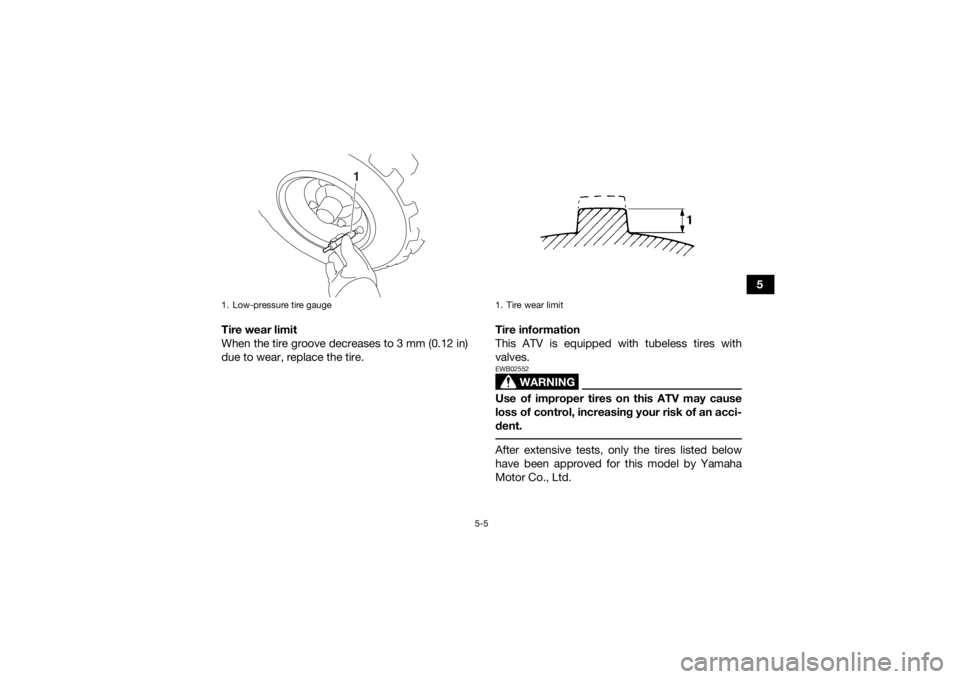
5-5
5
Tire wear limit
When the tire groove decreases to 3 mm (0.12 in)
due to wear, replace the tire. Tire information
This ATV is equipped with tubeless tires with
valves.
WARNING
EWB02552Use of improper tires on this ATV may cause
loss of control, increasing your risk of an acci-
dent. After extensive tests, only the tires listed below
have been approved for this model by Yamaha
Motor Co., Ltd.
1. Low-pressure tire gauge
1
1. Tire wear limit
UBW460E0.book Page 5 Monday, May 23, 2016 11:12 AM
Page 54 of 132

5-6
5Aftermarket tires and rims
The tires and rims that came with your ATV were
designed to match the performance capabilities
and to provide the best combination of handling,
braking, and comfort. Other tires, rims, sizes, and
combinations may not be appropriate.
EBU19841Chassis fastenersMake sure that all nuts, bolts and screws are
properly tightened.
EBU33810Instruments and switchesCheck that all instruments and switches are work-
ing properly. Correct if necessary.
Front:
Manufacturer/model:DURO/DI2040
Size: AT16 x 6.5-7
Ty p e : Tu b e l e s s
Rear: Manufacturer/model:DURO/DI2041
Size: AT16 x 7-7
Ty p e : Tu b e l e s s
UBW460E0.book Page 6 Monday, May 23, 2016 11:12 AM
Page 55 of 132
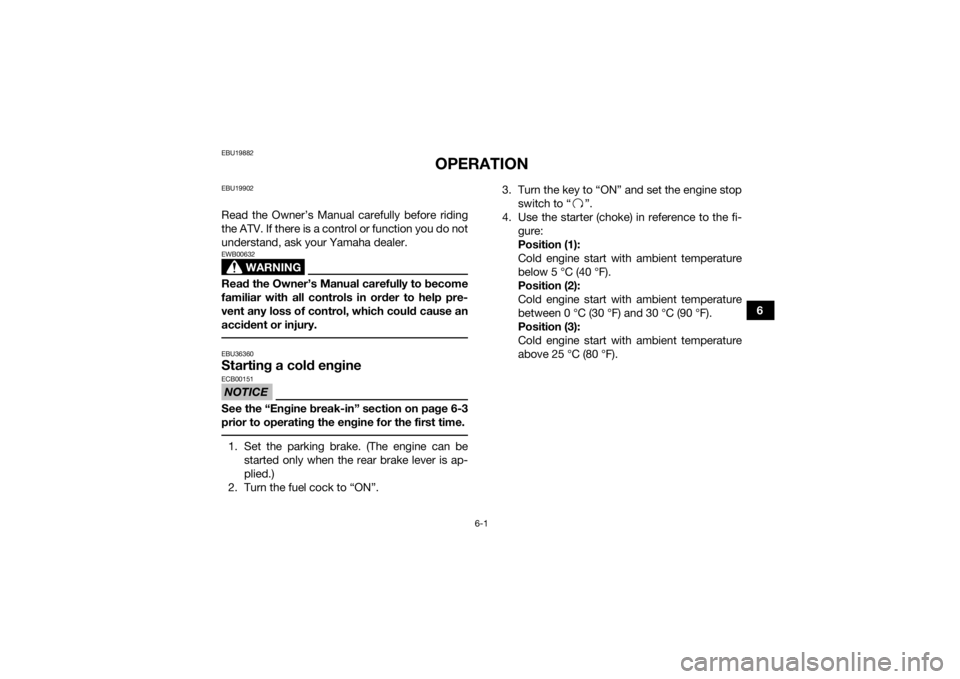
6-1
6
EBU19882
OPERATION
EBU19902Read the Owner’s Manual carefully before riding
the ATV. If there is a control or function you do not
understand, ask your Yamaha dealer.
WARNING
EWB00632Read the Owner’s Manual carefully to become
familiar with all controls in order to help pre-
vent any loss of control, which could cause an
accident or injury. EBU36360Starting a cold engineNOTICEECB00151See the “Engine break-in” section on page 6-3
prior to operating the engine for the first time. 1. Set the parking brake. (The engine can bestarted only when the rear brake lever is ap-
plied.)
2. Turn the fuel cock to “ON”. 3. Turn the key to “ON” and set the engine stop
switch to “ ”.
4. Use the starter (choke) in reference to the fi- gure:
Position (1):
Cold engine start with ambient temperature
below 5 °C (40 °F).
Position (2):
Cold engine start with ambient temperature
between 0 °C (30 °F) and 30 °C (90 °F).
Position (3):
Cold engine start with ambient temperature
above 25 °C (80 °F).
UBW460E0.book Page 1 Monday, May 23, 2016 11:12 AM
Page 56 of 132
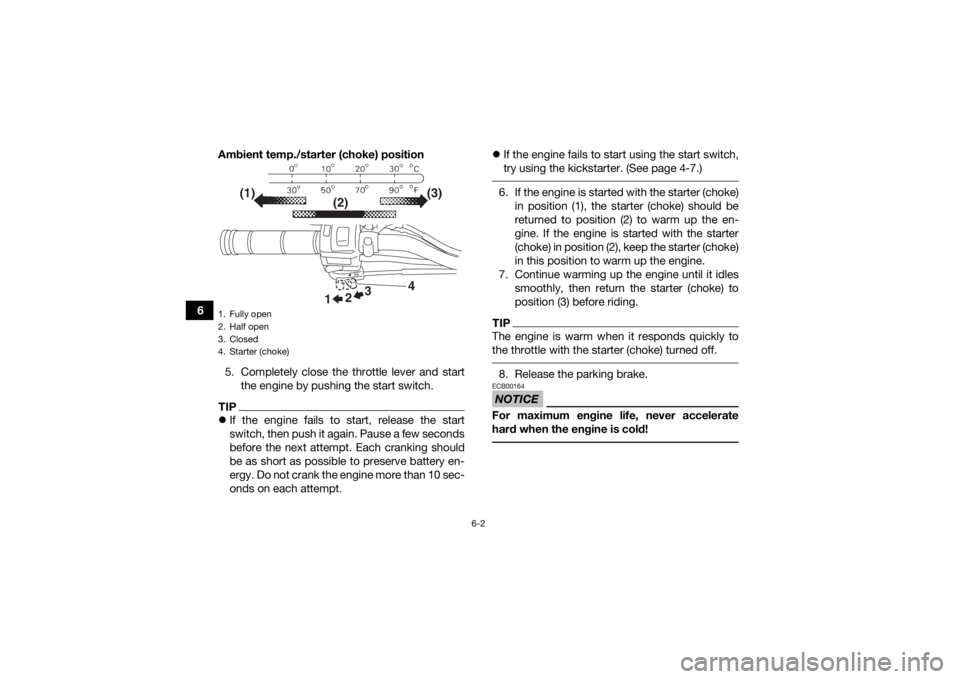
6-2
6Ambient temp./starter (choke) position
5. Completely close the throttle lever and start the engine by pushing the start switch.
TIPIf the engine fails to start, release the start
switch, then push it again. Pause a few seconds
before the next attempt. Each cranking should
be as short as possible to preserve battery en-
ergy. Do not crank the engine more than 10 sec-
onds on each attempt.
If the engine fails to start using the start switch,
try using the kickstarter. (See page 4-7.)
6. If the engine is started with the starter (choke)
in position (1), the starter (choke) should be
returned to position (2) to warm up the en-
gine. If the engine is started with the starter
(choke) in position (2), keep the starter (choke)
in this position to warm up the engine.
7. Continue warming up the engine until it idles smoothly, then return the starter (choke) to
position (3) before riding.TIPThe engine is warm when it responds quickly to
the throttle with the starter (choke) turned off. 8. Release the parking brake.NOTICEECB00164For maximum engine life, never accelerate
hard when the engine is cold!
1. Fully open
2. Half open
3. Closed
4. Starter (choke)
4
3
2
1
(1) (3)
(2)
UBW460E0.book Page 2 Monday, May 23, 2016 11:12 AM
Page 57 of 132
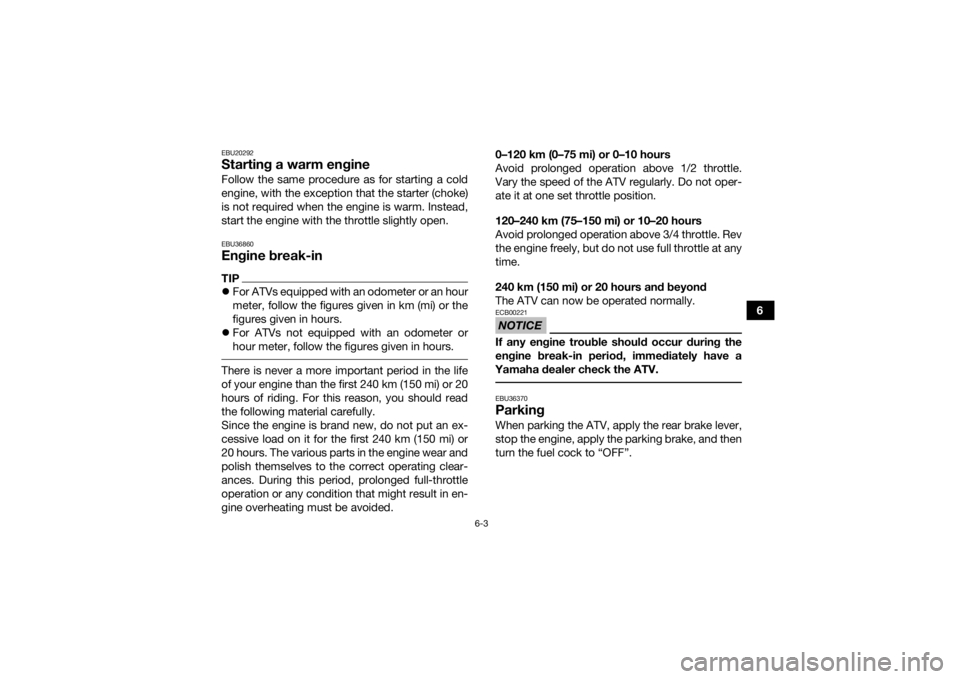
6-3
6
EBU20292Starting a warm engineFollow the same procedure as for starting a cold
engine, with the exception that the starter (choke)
is not required when the engine is warm. Instead,
start the engine with the throttle slightly open.EBU36860Engine break-inTIPFor ATVs equipped with an odometer or an hour
meter, follow the figures given in km (mi) or the
figures given in hours.
For ATVs not equipped with an odometer or
hour meter, follow the figures given in hours. There is never a more important period in the life
of your engine than the first 240 km (150 mi) or 20
hours of riding. For this reason, you should read
the following material carefully.
Since the engine is brand new, do not put an ex-
cessive load on it for the first 240 km (150 mi) or
20 hours. The various parts in the engine wear and
polish themselves to the correct operating clear-
ances. During this period, prolonged full-throttle
operation or any condition that might result in en-
gine overheating must be avoided. 0–120 km (0–75 mi) or 0–10 hours
Avoid prolonged operation above 1/2 throttle.
Vary the speed of the ATV regularly. Do not oper-
ate it at one set throttle position.
120–240 km (75–150 mi) or 10–20 hours
Avoid prolonged operation above 3/4 throttle. Rev
the engine freely, but do not use full throttle at any
time.
240 km (150 mi) or 20 hours and beyond
The ATV can now be operated normally.
NOTICEECB00221If any engine trouble should occur during the
engine break-in period, immediately have a
Yamaha dealer check the ATV. EBU36370ParkingWhen parking the ATV, apply the rear brake lever,
stop the engine, apply the parking brake, and then
turn the fuel cock to “OFF”.
UBW460E0.book Page 3 Tues day, June 7, 2016 4:17 PM
Page 58 of 132
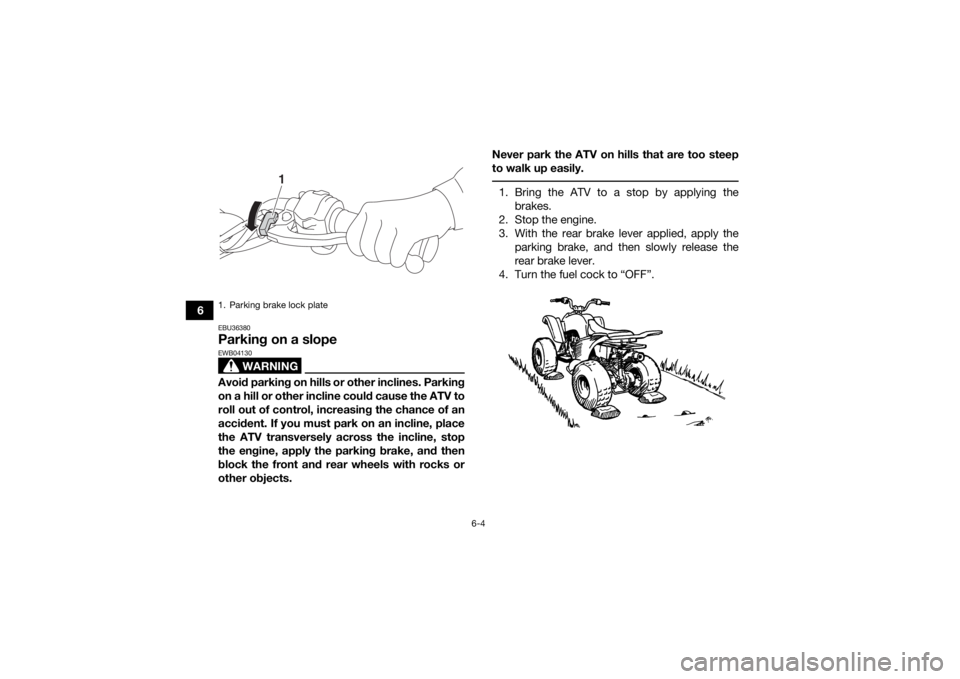
6-4
6
EBU36380Parking on a slope
WARNING
EWB04130Avoid parking on hills or other inclines. Parking
on a hill or other incline could cause the ATV to
roll out of control, increasing the chance of an
accident. If you must park on an incline, place
the ATV transversely across the incline, stop
the engine, apply the parking brake, and then
block the front and rear wheels with rocks or
other objects.Never park the ATV on hills that are too steep
to walk up easily.
1. Bring the ATV to a stop by applying the
brakes.
2. Stop the engine.
3. With the rear brake lever applied, apply the parking brake, and then slowly release the
rear brake lever.
4. Turn the fuel cock to “OFF”.
1. Parking brake lock plate
1
UBW460E0.book Page 4 Monday, May 23, 2016 11:12 AM
Page 59 of 132

6-5
6
EBU20911Accessories and loadingEBU20922Genuine Yamaha Accessories
Choosing accessories for your ATV is an impor-
tant decision. Genuine Yamaha Accessories,
which are available only from a Yamaha dealer,
have been designed, tested, and approved by
Yamaha for use on your ATV. Many companies with no connection to Yamaha manufacture parts
and accessories or offer other modifications for
Yamaha vehicles. Yamaha is not in a position to test the products that these aftermarket compa-
nies produce. Therefore, Yamaha can neither en-
dorse nor recommend the use of accessories not
sold by Yamaha or modifications not specifically
recommended by Yamaha, even if sold and in-
stalled by a Yamaha dealer.
Aftermarket parts, accessories, and modifica-
tions
While you may find aftermarket products similar in
design and quality to genuine Yamaha Accesso-
ries, recognize that some aftermarket accessories
or modifications are not suitable because of po-
tential safety hazards to you or others. Installing aftermarket products or having other modifica-
tions performed to your ATV that change any of
the vehicle’s design or operation characteristics
can put you and others at greater risk of serious
injury or death. You are responsible for injuries re-
lated to changes in the vehicle.
Keep the following in mind when considering an
accessory or operating an ATV which has acces-
sories.
Accessories should be rigidly and securely
mounted. An accessory which can shift position
or come off while you are riding could affect
your ability to control the ATV.
Do not mount an accessory where it could inter-
fere with your ability to control the ATV. Exam-
ples include (but are not limited to) a heavy or
bulky object attached to the handlebars which
could make steering difficult, an accessory that
limits your ability to move around on the seat, or
one that limits your view.
Use extra caution when riding an ATV with ac-
cessories. The ATV may handle differently than
it does without accessories.UBW460E0.book Page 5 Monday, May 23, 2016 11:12 AM
Page 60 of 132
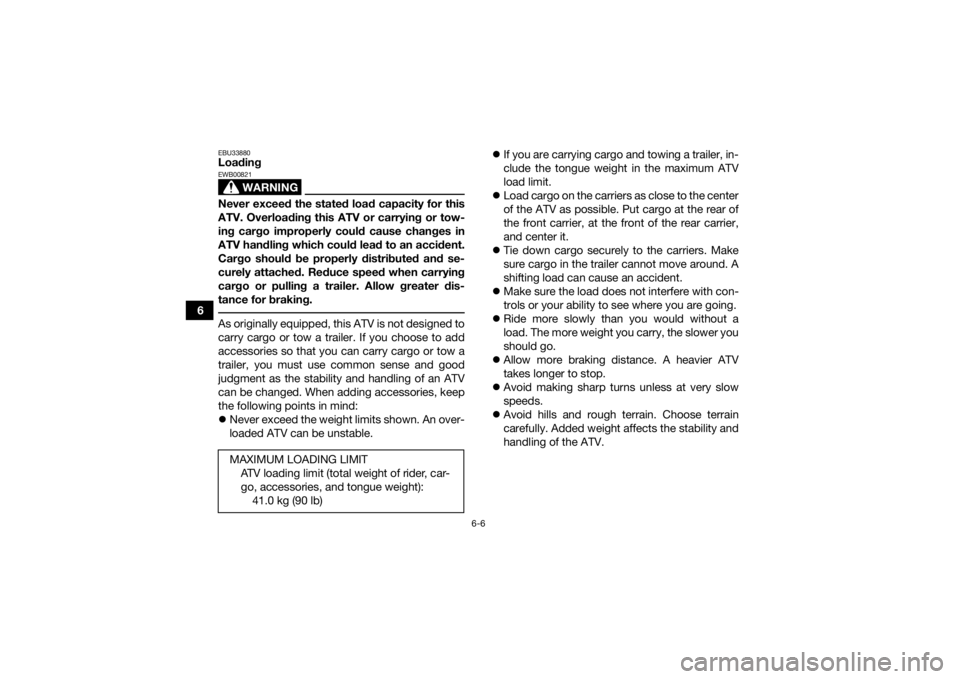
6-6
6
EBU33880Loading
WARNING
EWB00821Never exceed the stated load capacity for this
ATV. Overloading this ATV or carrying or tow-
ing cargo improperly could cause changes in
ATV handling which could lead to an accident.
Cargo should be properly distributed and se-
curely attached. Reduce speed when carrying
cargo or pulling a trailer. Allow greater dis-
tance for braking. As originally equipped, this ATV is not designed to
carry cargo or tow a trailer. If you choose to add
accessories so that you can carry cargo or tow a
trailer, you must use common sense and good
judgment as the stability and handling of an ATV
can be changed. When adding accessories, keep
the following points in mind:
Never exceed the weight limits shown. An over-
loaded ATV can be unstable.
If you are carrying cargo and towing a trailer, in-
clude the tongue weight in the maximum ATV
load limit.
Load cargo on the carriers as close to the center
of the ATV as possible. Put cargo at the rear of
the front carrier, at the front of the rear carrier,
and center it.
Tie down cargo securely to the carriers. Make
sure cargo in the trailer cannot move around. A
shifting load can cause an accident.
Make sure the load does not interfere with con-
trols or your ability to see where you are going.
Ride more slowly than you would without a
load. The more weight you carry, the slower you
should go.
Allow more braking distance. A heavier ATV
takes longer to stop.
Avoid making sharp turns unless at very slow
speeds.
Avoid hills and rough terrain. Choose terrain
carefully. Added weight affects the stability and
handling of the ATV.
MAXIMUM LOADING LIMIT ATV loading limit (total weight of rider, car-
go, accessories, and tongue weight):41.0 kg (90 lb)UBW460E0.book Page 6 Monday, May 23, 2016 11:12 AM